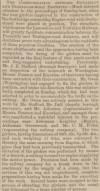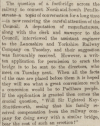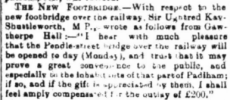There was another footbridge built by a local council in 1886, reported in a depth of detail makes it a good example. This is the bridge in Burnley from Raglan Road to Derby Street, over the L&Y line that's still there. LCC are currently planning to built a new one to replace what I assume is this 1886 one, which was taken down in ca. 2013 as unsafe. it was longer than the one in Padiham - 100' x 6', from an embankment at one end to a stair down to near track level (rebuilt at some stage) at the other.
Earlier reports say that the bridge was surveyed and discussed in January 1886, when "a representation will be made with the railway company". The company supported the proposal, and suggested "an interview". The corporation approved this in March, plans and specifications were drawn up by the borough engineer, for a lattice girder bridge. Borrowing of £800 was arranged ("but it might not all be spent"), the tender advertised in May, and it was finished in November!
I suggest that's a more appropriate comparator for the (yet to be built) one
Yes, I think this is an excellent comparison with the one at Padiham. Thanks for taking the time and effort to find that article. It's extremely helpful, in the fact it describes the co-operation between the council and the railway company. it mentions who was attending its construction (including the Mayor) and why Sunday was picked for the work.
The footbridge at Padiham was slightly different in the fact it was all iron, by that I mean the steps either side were iron too. Perhaps the construction here was - fix the main four supporting posts first, then the main girders, finally the steps are added - maybe.
The article about the Burnley footbridge mentions the Mayor, at Great Harwood station there's no mention about the Mayor attending the opening but it does mention
several councillors. This footbridge officially opened Monday 18 November 1901.
The opening day (a Monday) also looks to back up bridge construction on a Sunday or Sundays.
Question:
I presume there would have been some sort of ceremony? red tape and a pair of scissors?
As I've mentioned earlier, the were only three footbridges over this line, one of which remains a complete mystery. It connected a footpath which ran from the Eastern end of Blackburn near a farm to the Leeds & Liverpool canal - you can see it here (but suggest you zoom out to get your bearings):
Perhaps this was the oldest of them all? - My reasoning comes from the fact that the line cuts an existing footpath and I've learnt railway companies had to make some sort of crossing (as if the railway line was not there). This last footbridge crosses over Cunliffe railway cutting which was dug out sometime 1870-1875 ish.
If anyone could help with this final footbridge I would be very grateful!!



